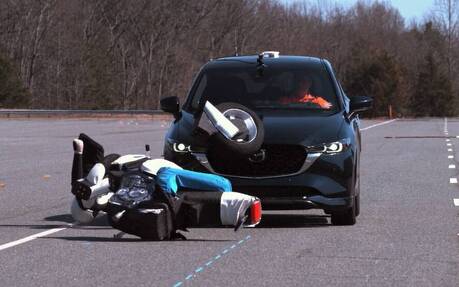Just One Compact SUV Aces IIHS’ New Front Crash Prevention Test
After updating its vehicle-to-vehicle front crash prevention test to address crashes that occur at higher speeds and those in which the struck vehicle is a motorcycle or large truck, the U.S. Insurance Institute for Highway Safety (IIHS) came to a sad conclusion: only one of the first 10 compact SUVs evaluated—covering the 2023-2024 model years—earns a good rating.
We’re talking about the Subaru Forester which, as you probably know by now, is completely redesigned for 2025. A stellar reputation for safety means its score isn’t likely to change with the new generation.
- Also: Only One Automated Driving System Gets Passing Grade From IIHS
- Also: IIHS Names the Safest Vehicles in 2024, Here's the Full List
The two best-selling compact SUVs on the market, namely the Toyota RAV4 and Honda CR-V, get an acceptable rating from the IIHS. The Ford Escape, Hyundai Tucson and Jeep Compass can do no better than a marginal rating, while the Chevrolet Equinox, Mazda CX-5, Mitsubishi Outlander and Volkswagen Taos are all rated poor.
“The vast majority of new vehicles now come with automatic emergency braking, and our research shows the technology prevents as many as half of all front-to-rear crashes. This new, tougher evaluation targets some of the most dangerous front-to-rear crashes that are still happening,” IIHS President David Harkey said.
The original vehicle-to-vehicle front crash prevention evaluation was conducted at speeds of 20 km/h and 40 km/h, but it was discontinued at the end of 2022 because all the vehicles tested by the IIHS were earning the top rating of superior. Now, the evaluation includes trials run at speeds of 50 km/h, 60 km/h and 70 km/h. In addition to a passenger car target, it also examines performance with a motorcycle target and a semitrailer.
The trials using targets evaluate both the forward collision warning and automatic emergency braking (AEB) systems. In each test run, an engineer drives the test vehicle toward the target at the selected speed and records when the forward collision warning occurs and how much the AEB system slows the vehicle to prevent or mitigate the impending impact. If the test vehicle fails to achieve a minimum speed reduction at the slower test speeds, only the forward collision warning system is evaluated in the higher-speed tests.
According to the IIHS, the good-rated Forester avoided a collision with the passenger car target at every test speed and avoided hitting the motorcycle target at both 50 km/h and 60 km/h. Critically, the forward collision warning alerts came more than the required 2.1 seconds before the projected time of impact in all the trials and also in those conducted with the trailer.
A vehicle with a marginal rating like the Escape managed to avoid hitting the passenger car and motorcycle targets at the 50 km/h test speed and slowed by a modest amount in the higher speed tests, regardless of where the targets were positioned. However, it lost several points because its forward collision warning came too late every time.
The poor-rated Equinox, meanwhile, slowed modestly in the 50 km/h test with the passenger car target and barely reduced speed at all with the motorcycle target, the IIHS found. Will the next-generation 2025 model perform better? We kind of doubt it, but let’s wait until next year to get the answer.
